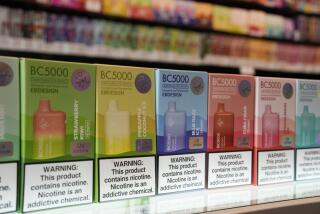High Court Rules Color of Money Can Be Pepto-Bismol Pink
- Share via
WASHINGTON — A company can trademark a “color, pure and simple” if the shade identifies the product brand in the public’s mind, the U.S. Supreme Court ruled Tuesday.
The 9-0 decision is a victory for the makers of leading brand-name products. It means, for example, that a company such as Owens-Corning can market its pink Fiberglas insulation exclusively, while Nutrasweet can seek similar trademark protection for its pale blue packets of artificial sweetener.
At the same time, the decision is a setback for store-brand products that often imitate the basic look, including the color, of the leading brands. For example, Pepto-Bismol is the recognized brand of liquid medicine for an upset stomach, but its store-brand competitors have copied its distinctive pink hue.
Before Wednesday, it was unclear whether color itself could be a trademark.
“Color alone, at least sometimes, can meet the basic legal requirements for use as a trademark. It can act as a symbol that distinguishes a firm’s goods and identifies their source,” Justice Stephen G. Breyer wrote for the court.
But he stressed that the color may not be simple and “functional.” A maker of orange juice could not patent an orange shade for its cartons, nor could a manufacturer of fire extinguishers seek exclusive use of bright red. These shades identify the basic product, but they do not conjure up a distinct brand.
In 1985, the U.S. Patent and Trademark Office granted a trademark for the pink color of Fiberglas, but some federal appeals courts did not accept the view that color itself can be a trademark.
The case before the court this week arose over a dispute between two makers of dry-cleaning presses.
Since 1957, Chicago-based Qualitex Co. had made presses with a “unique green-gold color.” In 1989, a competitor, San Fernando-based Jacobson Products Co., began marketing press pads with the same color.
Qualitex sued, and a federal judge in Los Angeles found Jacobson guilty of a trademark infringement. But the U.S. 9th Circuit Court of Appeals in San Francisco overturned the judgment on grounds that a color alone cannot stand as a trademark.
In reversing that decision, the high court cited the broad wording of the federal trademark statute.
The Lanham Act of 1946 gives a seller or producer the right to register a trademark, “including any word, name, symbol or device” that identifies or symbolizes the product.
In the past, the Patent and Trademark Office has authorized trademarks for a particular shape, such as the Coca-Cola bottle; a sound, such as NBC’s three chimes, and even a particular scent used on a brand of sewing thread.
“If a shape, a sound and a fragrance can act as symbols, why . . . can a color not do the same?” Breyer asked. As long as the shade “identifies and distinguishes a particular brand,” it can be a trademark, he said.
The ruling will encourage more companies to seek trademarks for their products, said Sheldon H. Klein, an expert in trademark law in Washington.
“Only a few have tried before, but I think this will make companies a lot bolder,” he said. “But courts will still have to look at it on a case-by-case basis.”
More to Read
Inside the business of entertainment
The Wide Shot brings you news, analysis and insights on everything from streaming wars to production — and what it all means for the future.
You may occasionally receive promotional content from the Los Angeles Times.











